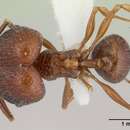en
names in breadcrumbs


Taxonomy. The genus Acanthomyrmex is assigned to the tribe Myrmecinini together with Myrmecina, Perissomyrmex and Pristomyrmex (Bolton 2003). Workers of Vietnamese species have the following features (see also Moffett 1986; Eguchi et al. 2008).
Worker dimorphic; frontal lobe reduced, in full-face view only partially concealing the torulus; frontal carina present, usually conspicuous; antennal scrobe present, usually conspicuous; anteromedian margin of clypeus weakly convex with a shallow median emargination in major; anteromedian margin of clypeus always armed with 2 to several processes in minor; median clypeal seta reduced or absent in major, but always present in minor; lateral portions of clypeus not forming a conspicuous ridge in front of torulus in major, but raised into a ridge in front of torulus in minor; mandible in major massive, edentate or armed with a few indistinct teeth on masticatory margin; mandible in minor broadly triangular, and armed with 5-10 small to tiny teeth in addition to relatively conspicuous apical and preapical teeth; antenna 12-segmented, with 3-segmented club; eye moderately developed; mesosoma short and robust especially in major; promesonotal suture absent dorsally; metanotal groove obsolete or shallow dorsally; propodeum armed with a pair of long spines; propodeal lobe well developed, angulately produced posterodorsad; petiole pedunculate anteriorly and with distinct node; postpetiole much shorter than petiole; suture between first gastral tergite and sternite basally in the form of a rounded M-shape; postpetiole articulated at base of the M.
The minor worker of Acanthomyrmex is similar to the worker of Pristomyrmex , but in the latter the antenna is 11-segmented, the masticatory margin of the mandible is almost vertical to the basal margin and 3-, 4- or 5-toothed, and the suture between first gastral tergite and sternite is not in the form of a rounded M-shape.
Vietnamese species. One species described from Vietnam: humilis Eguchi, Bui & Yamane (type locality: Nam Cat Tien) and a second species recognized by us from Vietnam: glabfemoralis Zhou & Zheng (Chua Yen Tu, Cuc Phuong, Ky Thuong, Pu Mat, Tay Yen Tu, Van Ban).
Bionomics. Acanthomyrmex species nest in dead twigs and wood fragments, and under or between stones. Colonies of A. glabfemoralis contain a single dealate normal queen, or instead contain single or multiple dwarf queens, while colonies of A. humilis contain ergatoids only (Eguchi et al. 2008). Acanthomyrmex glabfemoralis and A. humilis gather seeds (Eguchi et al. 2004, Eguchi pers. observ.).
Operaria: Clypeus convexus, inter antennarum insertiones productus, margine antico recto, denticulis paucis, minutis instructo, ab area frontali limite obsoleto separatus. Mandibulae trigonae, latae, minute denticulatae. Antennae ori proxime insertae, 12 - articulatae, clava 3 - articulata, parum incrassata. Laminae frontales distantes, humiles, ultra oculos prolongatae, sulcum antennalem limitantes. Thorax superne sine suluris, pronoto metanotoque longe bispinosis. Petioli segmentum 1. postice cum nodo bispinoso seu bidentato; 2. globosum. Calcaria posteriora Simplicia.
Miles: Caput permagnum, pagina inferiore cum thorace articulatum. Clypeus antice medio sinuatus, caeterum ut in operaria. Mandibulae superne convexae, inferius excavatae, margine masticatorio duplice, scilicet superiore recto, cultrato, inferiore dente valido armata. Laminae frontales magis prominentes; sulcus antennalis totum scapum accipiens, inde angulatum flexus et usque ad oculum descendens pro receptione baseos flagelli. Antennae breviores quam in operaria. Thorax superne sine suturis, pronoto inermi, melanoto spinis - longis erectis. Pedunculus ut in operaria, nodi 1. dentibus brevioribus.
J'etablis ce genre remarquable sur trois especes, dont une seule a ete decrite par F. Smith, sous le nom de Pheidole notabilis ; elle provient de l'ile de Batjan. Les deux autres sont inedites. - A premiere vue, il semble se rapprocher de Pheidole , dont il est bien distinct par la structure du thorax et le mode d'insertion de la tete sur le corselet, chez le soldat. L'insertion des antennes, tres rapprochee de la bouche, reduit l'epistome a ne former a cet endroit qu'un simple lisere a bord posterieur tranchant, entourant la fossette antennaire, comme chez Pristomyrmex . Le thorax sans suture ni impression, ainsi que le systeme' de sculpture, constitue par de grosses fossettes piligeres, rappelle egalement les Pristomyrmex . C'est avec ces derniers que le nouveau genre me parait offrir les affinites les plus importantes. '
F. Smith attribue a son P. notabilis des mandibules sans dents, chez l'ouvriere, comme chez le soldat. Il n'a probablement pas su voir les petites dents espacees que je trouve aux mandibules de l'ouvriere, chez mes deux especes nouvelles.
Acanthomyrmex is a genus of ants in the subfamily Myrmicinae.[1] The genus is known from South East Asia. Its species are dimorphic, with major workers in some genera having heads twice the length (and ten times the volume) than that of the minor workers. They live in small colonies and are rarely collected in the field.[2] There are 17 species of Acanthomyrmex.[3]
Acanthomyrmex is a genus of ants in the subfamily Myrmicinae. The genus is known from South East Asia. Its species are dimorphic, with major workers in some genera having heads twice the length (and ten times the volume) than that of the minor workers. They live in small colonies and are rarely collected in the field. There are 17 species of Acanthomyrmex.